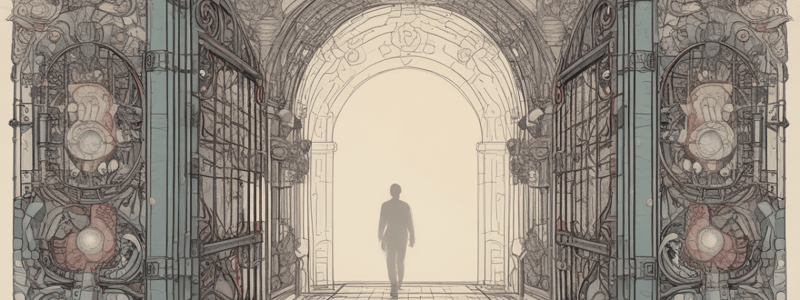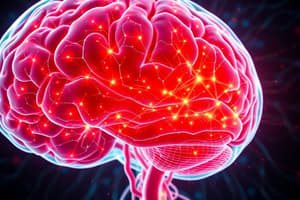Podcast
Questions and Answers
What is responsible for the paradoxical analgesic effect of capsaicin?
What is responsible for the paradoxical analgesic effect of capsaicin?
- Central sensitization
- TRPV sensitizers
- Exogenous TRPV1 activators
- Long exposure to capsaicin (correct)
Which type of fibers can begin to produce pain at low thresholds in the context of central sensitization?
Which type of fibers can begin to produce pain at low thresholds in the context of central sensitization?
- D fibers
- B fibers
- E fibers
- C fibers (correct)
What contributes to tactile allodynia in the spinal cord?
What contributes to tactile allodynia in the spinal cord?
- Long exposure to capsaicin
- Inhibition of GABA and glycine (correct)
- Activation of neuropeptide receptors
- Endocannabinoid anandamide
Which neurochemical receptors play a major role in central sensitization?
Which neurochemical receptors play a major role in central sensitization?
What effect does damage-induced inflammation have on TRPV sensitization?
What effect does damage-induced inflammation have on TRPV sensitization?
What is a key consequence of CNS plasticity after nerve injury?
What is a key consequence of CNS plasticity after nerve injury?
What is the role of prostaglandins in pain perception?
What is the role of prostaglandins in pain perception?
In the context of gate control theory, how does non-painful input affect painful input?
In the context of gate control theory, how does non-painful input affect painful input?
Which neurotransmitter is involved in amplifying the pain signal?
Which neurotransmitter is involved in amplifying the pain signal?
What is the main characteristic of neuropathic pain?
What is the main characteristic of neuropathic pain?
How does peripheral sensitization contribute to pain hypersensitivity?
How does peripheral sensitization contribute to pain hypersensitivity?
What is the impact of TRPV1 expression changes in diabetic neuropathy?
What is the impact of TRPV1 expression changes in diabetic neuropathy?
Flashcards are hidden until you start studying
Study Notes
TRPV1 Activators
- Exogenous: temperature > 43°C (109°F), acidic conditions, capsaicin
- Endogenous: low pH (acidic conditions), anandamide, N-oleyl-dopamine, N-arachidonoyl-dopamine
TRPV Sensitisers and Desensitisers
- Sensitisers: damage, inflammation (Prostaglandins, bradykinin activation of PLC) → increased sensitivity
- Desensitisers: long exposure to capsaicin → paradoxical analgesic effect
Ectopic Activity and Clinical Targets
- Spontaneous pain after injury: paresthesia, dysthesia, pain
- Clinical target: voltage-gated Na channels
Central Sensitization
- Amplifies pain and reduces threshold
- Mechanistic explanation: low threshold A or C fibers can produce pain, spread of sensitivity beyond areas of tissue injury or damaged nerve territory
- Players: synaptic changes, NMDA/AMPA/mGluR glutamate, substance P, NK1 receptors, Aβ fibers, neuropeptide expression, physical changes in spinal circuitry
- Loss of inhibition: GABA and glycine in the spinal cord
Pain Definition and Classification
- Definition: unpleasant sensory and emotional experience associated with actual or potential tissue damage
- Classification: nociceptive (transient, chronic), neuropathic pain, benign, cancer pain
Nociceptive Pain
- Capacity to detect potentially damaging stimuli
- Classification: somatic (deep, superficial), visceral (sensitive, stretch, ischaemia, inflammation)
Neuropathic Pain
- Major health problem: injured nervous system, persistent neural changes, increased sensitivity, decreased threshold
- Susceptible persons: genetic polymorphisms
- Heterogeneous/pathologic neural plasticity: differing etiologies, genetic/environmental factors
- Pathophysiology: sensory nerve damage, direct insult to primary neurons/peripheral neuropathy, cell death, decreased transduction, conduction, transmission
Studying That Suits You
Use AI to generate personalized quizzes and flashcards to suit your learning preferences.




